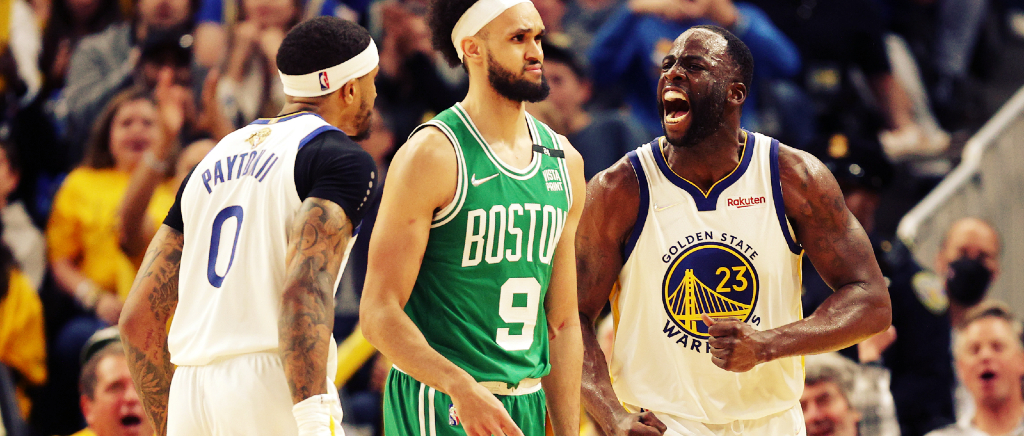
On multiple occasions, Draymond Green publicly held himself accountable for his Game 1 performance, an outing he clearly deemed below his individual standards. His four points on 2-of-12 shooting, three turnovers and good, but not great, defense contributed to the Golden State Warriors’ defeat, despite 34 points from Stephen Curry.
Nobody could tell Green he had to be better before he’d hammer home the sentiment himself. He’s Golden State’s second-best player, though has been defined by inconsistencies since returning from a back injury in mid-March. An optimal Warriors’ attack hinges, in some significant capacity, on him playing like the All-Star forward and generational defender he’s largely existed as since 2014-15.
From the opening possession of Sunday’s Game 2 in the NBA Finals, Green established that he would not scuffle again like he did in Game 1. Al Horford was a dominant force in the Boston Celtics’ Game 1 win. He scored a team-high 26 points, including six triples, pulled down six rebounds, handed out three dimes and imprinted himself defensively through wide-ranging outlets.
Upon Horford’s initial touch Sunday, Green confronted him, closed down his airspace and forced a jump ball as the two veterans stumbled to the hardwood. The comfort Horford enjoyed Thursday would not be replicated.
Green’s strategy to open Game 2 was a stark deviation from Game 1, when he, as well as the Warriors’ overarching defense, allowed Horford space on the perimeter to fire up eight long balls. Instead, they pressured the Celtics big man and clogged his shooting, passing, and driving windows. The result was two points on four shots and a runaway 107-88 win for Golden State. Horford’s release valve nature often helps catalyze Boston’s offense. It would not be available Sunday.
After that possession, though, Green quickly assumed the primary responsibility of Jaylen Brown, whose fourth-quarter tidal wave helped Boston snag Game 1 in a comeback victory. All evening, Green’s defensive versatility shone. His ground coverage, physicality and dexterity frustrated Brown. While the talented 25-year-old missed some looks he can usually convert, Green limited his scoring volume, both in total shots and quality attempts.
Brown’s poor ball control meshed like oil and water with Green’s snappy, pestering hands. Repeatedly, the Warriors big man disturbed Brown’s handle to quell creation endeavors. In Game 1, Brown tallied 18 drives, per NBA.com, leveraging his speed and strength to frequent the paint. In Game 2, he tallied six drives, with Green commonly turning him away.”
Part of what renders him such a historically dominant defender is his decisiveness. When Green commits to an action, he does not cautiously approach its execution. He embraces it, chest out, limbs swirling, and eliminates the chance for an offensive player to assess his options. Traps and ball pressure are immediate. Brown experienced that firsthand, while Jayson Tatum was occasionally the recipient as well.
Nekias Duncan of Basketball News brilliantly explained why pinning Green to Brown instead of Horford was such an impactful move. But the gist revolves around the fact that Green is among the most skilled stunt-and-recover players in NBA history. With Boston regularly slotting Brown as the lone teammate in the strong-side corner when Tatum is initiating, it allows Green to both bother Tatum’s advances and blanket Brown off the catch.
Green is exceptional at closing out to influence shooters. Closeouts do not routinely impact the outcome of threes, yet he seems like one of the select few who can actually alter them. The Warriors walled off the paint in Game 2 and Green’s ability to deter actions from the key, while still impeding shots from the perimeter factored into those defensive profits.
Much of the night, Golden State shrunk down pockets of space for Boston and pushed its offense farther out on the catch, especially during the second half. The Warriors’ physicality and interconnected off-ball defense sped up the Celtics’ decision-making. They were staunch on the perimeter and Green encountered success denying Tatum a handful of times.
Again, his decisiveness as a defender proved integral to his help rotations. He strikes with haste and flusters opponents. The way he neutralizes lob threats, precisely playing 1-on-2s and baiting drivers into shots or ill-advised passes, is uncanny for a 6-foot-6 forward. Many of the components of his abiding defensive excellence rested at the forefront of his redemptive Game 2.
At various points, Green guarded Tatum, Brown, Horford and Robert Williams III. He was a ball-screen trapper, rim protector, strong-side helper and on-ball stopper. The concept of defensive versatility should not be confined to positions. Defense is much more than merely on-ball expertise.
Flexibility of role, given the complexity and diversity of each player’s jobs on a possession, is perhaps more important than 1-4, 1-5 or 2-5 switchability. Green’s about as limber as they come in the league as it pertains to role flexibility, which is a prominent pillar of his exploits.
Before his two-month hiatus, he was likely the leader for Defensive Player of the Year this season. In Game 2, he reminded everyone why that was the case and helped Golden State bring these Finals back to a 1-1 draw.
